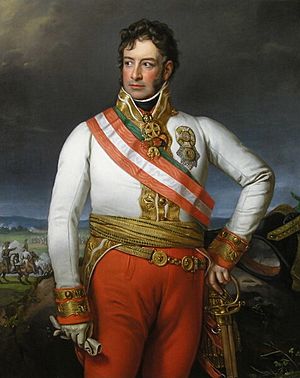Army Cross 1813/14 facts for kids
Quick facts for kids Army Cross 1813/14Armeekreuz für 1813/14 |
|
|---|---|

Army Cross 1813-14 with incorrect ribbon
|
|
| Country | |
The Army Cross for the Wars of 1813–14 was a special military award from the Austrian Empire. It was given out during the Napoleonic Wars, a big conflict in Europe. People also called it the "Cannon Cross" because it was made from captured enemy cannons!
This award was created on May 13, 1814, by Emperor Francis II of Austria. It was given to all soldiers who fought in the German Wars of Liberation against Emperor Napoleon I.
Contents
What Did the Army Cross Look Like?
The Army Cross was shaped like a "paw cross," which means its arms widen at the ends, a bit like an animal's paw. It was made from bronze, specifically from cannons taken from the French army. Around the arms of the cross, there was a laurel wreath, which is a symbol of victory and honor.
On the front of the cross, it said in Latin: "GRATI PRINCEPS ET PATRIA FRANC · IMP · AUG ·". This means "In gratitude, the ruler and fatherland, Emperor Franz." On the back, it said: "EUROPAE LIBERTATE ASSERTA MDCCCXIII/MDCCCXIV ·". This translates to "Those who ensured Europe's freedom 1813/1814."
This Army Cross was very important because it was the first time the Habsburg Monarchy (the rulers of Austria) gave out a military award to so many soldiers. Later, during World War I, a new award called the Karl Troop Cross was designed to look similar to this historic Army Cross.
How Was the Army Cross Worn?
Soldiers wore the Army Cross on the left side of their chest. It hung from a yellow ribbon that had a wide black stripe on its border.
Who Received This Award?
On October 18, 1814, a very important military leader named Field Marshal Karl Philipp, Prince of Schwarzenberg, received a special version of this award. He was the commander-in-chief, or top leader, of all the allied troops fighting against Napoleon.
His award was a "Grand Army Cross" made of gold. Unlike the regular cross, he wore his special gold cross around his neck. You can often see this unique gold cross in paintings of Karl Philipp, Prince of Schwarzenberg.
In total, about 100,000 Army Crosses were given out to soldiers who fought bravely in the wars of 1813–14.
See also
- List of Austrian orders and decorations


